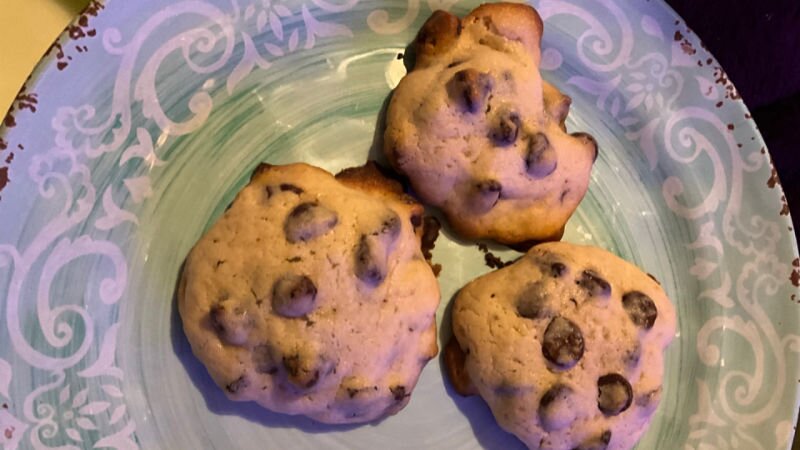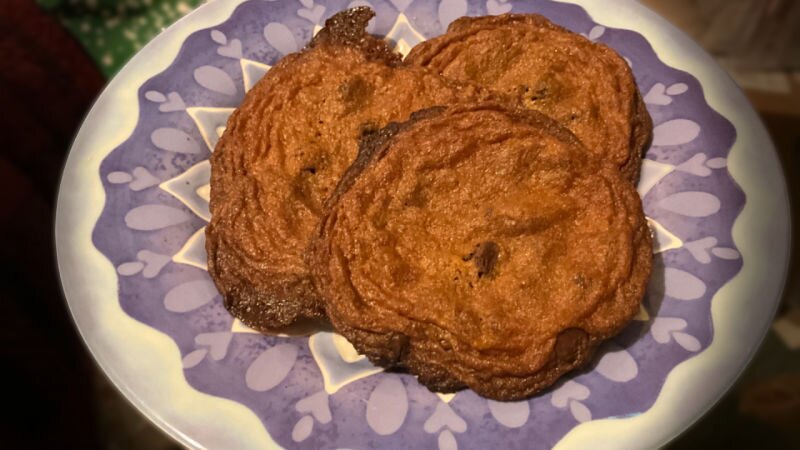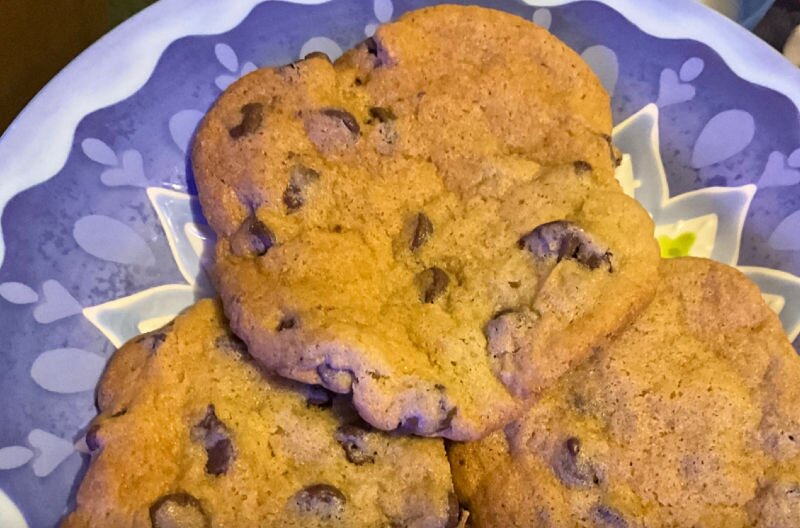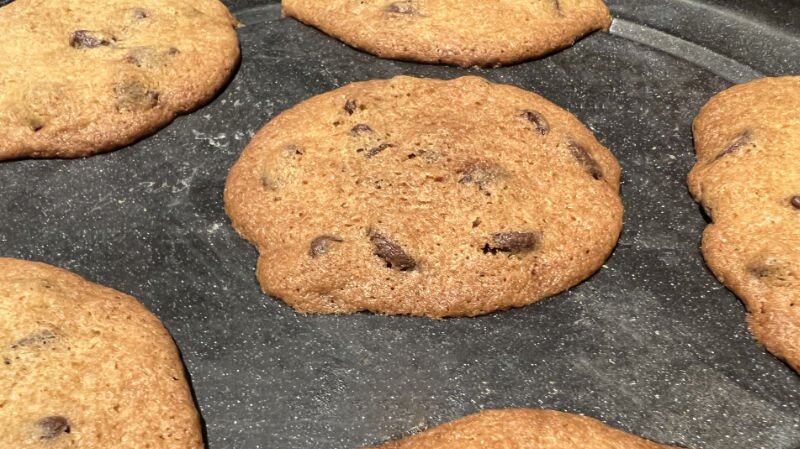This is the Kind of Cookie I Want
I’ve embarked on an important research project to further humanity’s understanding of the world. A project to delve deep into one of life’s most important questions. One that furthers the far reaches of science. One that helps to better understand… the chocolate chip cookie.
I love chocolate chip cookies. Something went south in the process of making them for me, though, and I wanted to find my way back to cookie home.
My family has always been serious about chocolate. My grandma taught me just how serious chocolate was when she’d help me categorize my trick-o-treating haul each year or when she’d pick out the entree at restaurants that best worked with the dessert she planned to eat. It’s in my DNA. This is serious.
It’s hard for me to imagine that the chocolate chip cookie is less than one hundred years old. That delicious combination of cookie crumb and gooey chocolate is what cookies have always dreamed of being, yet weren’t until Ruth Wakefield at Toll House Inn made the decision to chop up Nestlé chocolate and put it into a cookie.
Today there are countless varieties of chocolate chip cookies at every store and it’s a common menu item at fast food restaurants and bakeries. There are dozens of premade doughs ready for baking, alongside cookie dough ice cream and the like.
It’s so ubiquitous, we can take it for granted.
I did, although not entirely, because I’ve always loved homemade chocolate chip cookies the best.
Commercialized forms of chocolate chip cookies are almost always overly sweet for my taste. While other “ready to bake” cookie dough varieties can come close to homemade, oatmeal raisin is a safe bet there, it isn’t the same with that king of cookies.
Neither were my attempts to make chocolate chip cookies. Somewhere along the lines, they went off the rails.
The wide, winding path for me away from cookie bliss started with an experiment making sourdough chocolate chip cookies during the pandemic. They were fine but they tasted doughy, more bready than a true cookie. Fine, forget that attempt to use sourdough, but going back to the sourdough-free ones I was horrified to discover they all tasted doughy.
I tried different proportions, different ingredients. The cookies came out looking undercooked on top, even as the bottoms were scorched. Not only did they look unappetizing, they lacked the delightful texture and flavor I expected and remembered.

Remembering a long cherished food going back to childhood that does not taste right any longer can throw a person for a loop.
Was it the flour, of which I usually get the cheapest available? Changing that did nothing. Was it the store brand chocolate chips? No, not that either. What about… yeah, none of the ingredients being swapped for “better” alternatives did a dash of good.
Yes, I could buy the chocolate chip cookie dough or bakery chocolate chip cookies, but while they were more cookie-like in consistency, the sweetness overload of them left me longing.
A few weeks ago, I made peanut butter cookies — sourdough based ones even — and they tasted — surprise, surprise — like cookies. Why was it that the cookie of all cookies did not, but peanut butter ones did?
Setting aside peanut butter itself and the sourdough, since I tried both sourdough and non-sourdough chocolate chip cookies, what was different? One item: while both used baking soda, the peanut butter cookies had baking powder too.
A chemist could explain this better than I can, but in essence, baking powder is a combination of baking soda with an acidic ingredient that reacts with that baking soda either when the mix becomes wet or when it bakes. Modern baking powder reacts at both points.
The reaction of these ingredients causes “leavening,” the rising of dough (think what yeast does). While my goal wasn’t fluffier cookies, the rising (and sometimes subsequent falling) can affect how a dough browns and what kind of texture it has.
I was looking for both better browning and better texture. Perfect.
Call me a noble student of science, but I knew I had to make more cookies and see if baking powder might be the ticket.
Resetting from my Aldi chocolate chip instructions that simplified the mixing process, I returned to the official Toll House steps of mixing all the dry ingredients (with my baking powder addition therein) separately; creaming the sugars, butter, vanilla and eggs and then joining the two together slowly.
My first batch turned out odd looking but promising. Reading my measuring cup incorrectly, I put in about a third extra brown sugar, which caused the cookies to spread out too much and they were chewy and molassesy, but they weren’t overly sweet and they tasted a lot like cookies from happy memories.

It’s interesting to note that the overload of brown sugar didn’t make the cookies crazily sweet. If anything, as I’d soon learn, it moderated the cane sugar. Not the cookie I was looking for, but good and even worth returning to in the future.
I managed to perfectly follow the Toll House recipe, plus baking powder, on the second batch — yes, I am a self-sacrificing saint, aren’t I? — but found it less satisfying. The cookies I grew up with from my mom and grandma had less sugar than the Toll House recipe and for good reason: the official recipe lets the sugary sweetness dominate the rich chocolatey centerpiece.

I learned at an early age: the best cookies let the chocolate itself be the star, not the sugar.
Again in the name of science and the pursuit of good things for you, dear reader, I created trial lot No. 3. The same Toll House recipe with baking powder added and only a 1/2 cup of sugar rather than 3/4 cup.
Bingo.
Cheap flour and store brand chocolate chips did the heavy lifting just fine. The cookies tasted like they should with a somewhat salty cookie bringing into focus the deep, somewhat bitter taste of semi-sweet chocolate. A true chocolate lover’s cookie.

If you, like me, have felt like you’d lost your cookie way, join me “in the name of science.” Make a batch this week, and do it by following the Toll House recipe with that reduced, 1/2 cup of sugar and a single teaspoon of baking powder added to the mix of the other dry ingredients.
Research never tasted so good.

Timothy R. Butler is Editor-in-Chief of Open for Business. He also serves as a pastor at Little Hills Church and FaithTree Christian Fellowship.
You need to be logged in if you wish to comment on this article. Sign in or sign up here.

Start the Conversation